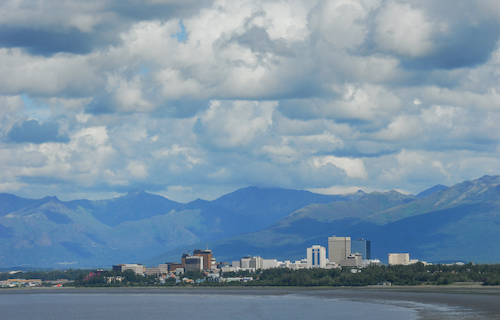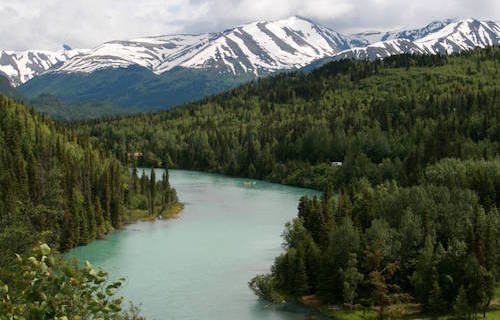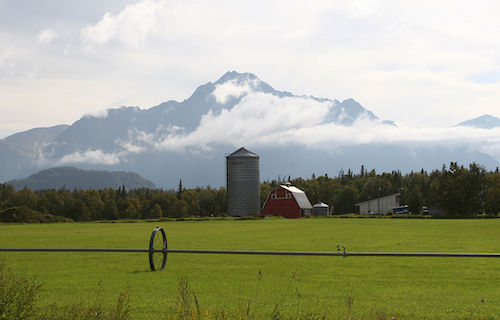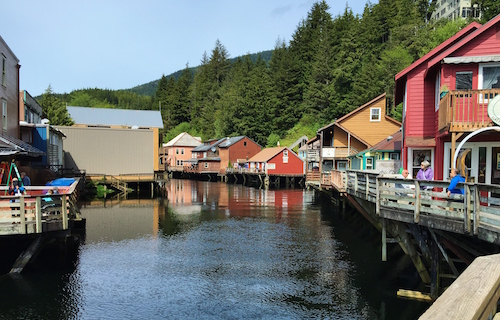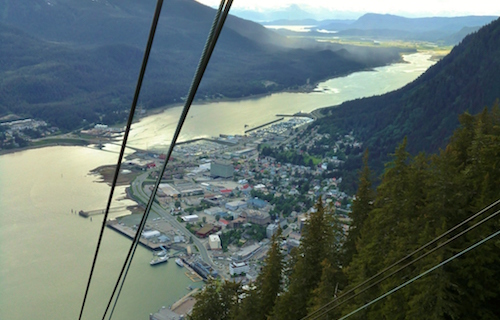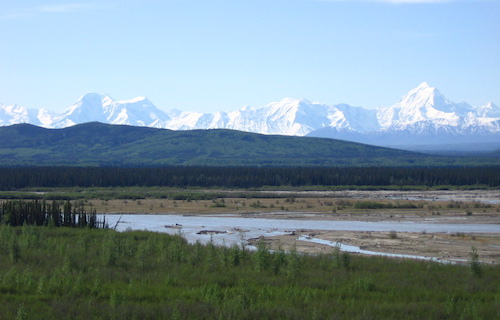Alaska Day Floor Speech
***As Prepared for Delivery***
Sen. Murkowski: Floor Statement on Alaska Day: October 18, 2011
***AS PREPARED FOR DELIVERY***
I rise to speak on the 144th anniversary of Alaska Day, the day that commemorates the first raising of the Stars and Stripes over Lord Baranof’s Castle in Sitka, Alaska. At the time, Sitka was called New Archangel, and until that moment, it was the capital of Russian America. We celebrate Alaska’s statehood today – October 18th – our now 52-year-old compact with the United States, and its promise to grant Alaskans the opportunity to participate equally with the other states of the Union.
Together with Hawaii, statehood for Alaska marked the last chapter in America’s great westward expansion. Of course that expansion began well before Alaska statehood, well before the purchase from Russia. It really harkens back to Thomas Jefferson’s Northwest Ordinances, which promised an equal footing to new states and the control of whatever lands would be necessary for a state government to stand up on its own and make the leap out of territorial status. This resulted in states like Ohio and Indiana forming as sovereign governments, with the federal government relinquishing almost all control over the lands within those borders. People came to build their lives in these new states, and with their new lives came roads, bridges, factories, and industry.
That set things in motion for expansion into the Far West – frontier states like Wyoming, Nevada, Utah, and Montana. Gold in California and Colorado brought an urgency to the expansion and the railroads helped accelerate and accommodate it. But as time passed, the terms began to change. Precedents were increasingly set for vast federal land withdrawals in the form of National Forests, Monuments, Parks and Preserves. The promise and the definition of equal footing changed during these times. Ultimately some states had more of an equal footing than others, as the newest western states would soon have to contend with federal land managers.
None of this took away from the hope that Alaskans felt when Secretary of State William Seward negotiated the purchase of Alaska from Tsar Nicholas for $7.2 million – a deal at 2 cents an acre. And so, back in Sitka, this day is always commemorated by the town’s biggest parade of the year. It’s a time of celebration when many Alaskans remember the hope they felt for a brighter future when we became the 49th State in the Union in 1959.
I was only a year old when President Eisenhower signed the Statehood Act into law. So I have felt, and I still feel, like I’ve grown up with Alaska – we have both matured over the years. Those that know me know that I can go on and on about the wonders of my state. Alaska is unparalleled in its beauty and potential and there has always been something classically American about Alaska. It is truly our nation’s last frontier – a place where it’s still possible for adventurous men and women to live the greatest version of the American dream.
Statehood itself was a dream for many years among our pioneers and our Native people, but it did not come quickly, and it did not come easily. Prior to statehood, we had only territorial status in the United States. That left us without a vote in Congress. We weren’t entitled to receive funding from many programs, including for highways. We were at the mercy of the generosity of the federal government and at the mercy of those out-of-state interests which had locked in a foothold over many of our resources. I can remember stories from my grandparents about the push for statehood stemming from the desire to control our fisheries – the salmon wars.
Ultimately, statehood came about after 92 long years, and only after heroic efforts from many great individuals – too many to do justice here, but for purposes of this statement I must invoke three names that some in this town, and some in this chamber, might remember.
The first is our former Governor and Senator, Ernest Gruening, whose seat in this chamber I am humbled to hold. Senator Gruening was an intellectual titan and the consummate public servant – he was an alumnus of Harvard Medical School, and a prolific journalist who served as Editor to both the New York Tribune and the magazine “The Nation”. He also contributed to the Atlantic Monthly. In the epic historical novel Alaska, James Michener credited Senator Gruening with publicizing the cause for Alaskan statehood at the national level, calling him “perceptive” and “gifted.” As a testament to his legacy, Ernest Gruening’s statue now stands just a few steps away from here in the Capitol Visitor Center.
Then there was Wally Hickel, our governor and the man who President Nixon was so impressed with that he named him Secretary of the Interior. Wally was a former boxer, a kid from Kansas who arrived in Alaska with 37 cents in his pocket and rose to prominence in business and politics. He was at the forefront of negotiating statehood and understood the critical balance between federal interests and state interests; between corporate interest and public interest. Governor Hickel is so important to this conversation because Alaska is where he saw and realized the American dream, all the while with an eye towards the future of our state. We lost Wally last spring, but his writings and vision continue to guide Alaska.
And third, a man I was privileged to work for and serve with, the late Senator Ted Stevens. I hold Senator Stevens, or Uncle Ted as we knew him in Alaska, in great personal and professional regard. He was a World War II pilot, a Harvard lawyer who served as a prosecutor in the territorial days, a Congressional Liaison to President Eisenhower, and an attorney for the Interior Department. Much of the legwork associated with statehood was Ted’s, and much of what Alaska has become is attributable directly to his work in this chamber. But Ted’s work and influence carried so much further than Alaska; his work in matters of national defense, telecom, and fisheries has shaped national and global policies. He was truly larger than life. He made Alaska matter in ways that nobody could imagine, and without him it is indisputable that we wouldn’t have the opportunities we have now.
The reason I invoke these names is to remind my colleagues about the consequential nature, the gravitas of the great men and women who made sure Alaska became our 49th state. These were exceptional Americans with an exceptional vision – they qualify as the Founding Fathers of my home state. They knew what Thomas Jefferson knew at the time of the Northwest Ordinances: that the new state of Alaska didn’t have the population or the infrastructure to support an economy, and that it would not succeed without open access to its huge natural resource base. This is why they negotiated 104 million acres of pure state land and a 90 percent share of revenues from resource development on federal lands, compared to the 50 percent enjoyed by the rest of the states. There was no clear path to Alaska’s self-sufficiency without these terms. And as a matter of fact, there still isn’t.
In 1958, the U.S. Senate’s official Committee Report on the Alaska Statehood Act promised Alaska that it would be given great latitude to develop its resources. It read, and I quote:
“Some of the additional costs connected with statehood will be met by granting the State a reasonable return from Federal exploitation of resources within the new State. In the past the United States has controlled the lion’s share of resources and, in some instances, retained the lion’s share of the proceeds. This situation, though, has not proved conducive to development of the Alaskan economy. … The Committee deems it only fair that when the State relieves the United States of most of its expense burden, the State should receive a realistic portion of the proceeds from resources within its borders.”
There’s more. Secretary of the Interior Fred Seaton, while in Alaska in early summer of 1958 to deliver speeches about Alaska’s statehood, said that the statehood compact, quote, “reaffirms Alaska’s preferential treatment in receiving 90 percent of all revenues from oil, gas and coal leasing on the public domain.” In Fairbanks he went further, promising, quote, “Since early this year the territory has received 90 percent of all oil lease revenues and the state of Alaska will continue to do so.”
Those statements are remarkably clear: Alaska would be allowed to develop its resources and receive most of the revenues from that development. And I wish I could stand here today, all these years later, and say those promises have been upheld. I wish I could go to sleep at night knowing that the federal government had kept its promises to the people of Alaska and that my children and their children will surely see our state continue to prosper and come into its own.
But the reality is that Alaska’s relationship with the federal government has become strained. The federal government has always had a significant presence in the Last Frontier, from the first Alaska Day until this one. But today, at a time when Alaskans need the federal government to act as our partner, it has become an obstacle. Its default position is no longer to enable prosperity for Alaskans; more often than not, the federal government now delays or really denies those opportunities. That leaves me worried about the future of Alaska not because of the global economy, not because of high unemployment levels, but because of the treatment we experience at the hands of our own federal government. And I’m here today to say that our treatment cannot go on like this, and I want to ensure my colleagues in the Senate understand why.
This may not be easy for some to see. Some believe that Alaska – and the rest of America, for that matter – is past the point where we need to develop our resources. Many of our newer members do not understand the promises made to Alaska upon statehood and therefore do not understand what has been happening since then. Adding to the complication is that our resource options have been greatly restricted over the course of decades, not individual months or years.
To understand what has changed, we can’t look back to the start of this administration, or even the last several. We have to go all the way back to the late 1970s, a time when much of Alaska had already been withdrawn into federal wilderness. President Carter and his Interior Secretary decided that wasn’t enough, and designated over 56 million more acres of new national monuments, 40 million more acres of wildlife refuges, and 11 million more acres of restricted National Forests. That would have been an unprecedented amount of land for the federal government to unilaterally withdraw if it were nationwide, but this land was all in Alaska. Not surprisingly, this came over the state’s objections.
Congress reacted to this tremendous federal overreach so that Alaska’s senators and lone Congressman, together with a few sympathetic colleagues, could at least try to control the impact. The negotiated truce was the Alaska National Interest Lands Conservation Act, or ANILCA for short.
In no uncertain terms, ANILCA was a compromise. And for his part, President Carter stated, upon signing ANILCA into law, that “100 percent of the offshore areas and 95 percent of the potentially productive oil and mineral areas will be available for exploration or for drilling.” That was a strong statement. It seemed pretty clear and even reassuring at the time. But today, it stands as probably the worst broken promise the federal government has ever made to the state of Alaska. As the Interior Department reported just this past spring, less than one percent of federal lands in Alaska are currently producing oil or natural gas. That’s an indictment. A significant portion of our lands have been placed off-limits, and where development is allowed, it is often stalled by federal red tape. That’s wrong, it’s unacceptable, and it’s to the detriment of both Alaska and our nation as a whole.
Alaska is nearly 4,000 miles from Washington, DC, and what makes news back home doesn’t always make news here. So I want to use part of my time today to provide the Senate with some of the many examples of how resource development in my home state is being held back.
Let’s start with mining. In 2009, the EPA attempted to halt the Kensington gold mine from proceeding in Southeast Alaska. This happened after two decades of agency review and legal challenges. It happened even though the Supreme Court had ruled that a crucial permit for the mine was indeed valid. The EPA was so unhappy with that decision that it jumped back in and sought to nullify the plan that had just held up to the scrutiny of the U.S. Supreme Court. This was not an effort to protect the environment, as the EPA’s proposal was demonstrably worse for the environment, but an effort to stop a mine at all costs – regardless of the consequences for the local economy, or the hundreds of Alaskans who were depending on jobs from it.
More recently, we’ve seen Senators from other states challenge a mine that could one day be located in Southwest Alaska. Those Senators have asked the EPA to consider a preemptive veto of the mine, even before a plan for it is proposed. For my part, I’ve said that a preemptive veto makes no more sense than a preemptive approval, and that we should provide a robust environmental review when and if a permit application is submitted. We don’t have a habit of hastily approving mines in the United States – in fact, we rank dead last among all countries in the amount of time it takes to review permits – and this mine will have to secure at least 67 different permits, approvals, and authorizations from federal, state, and local governments. That represents 67 chances for the mine to be delayed, modified, or halted, but some apparently believe that process is still not sufficient.
Then there’s the wholesale destruction of the timber industry in Southeast Alaska. On this point I would remind my colleagues that Alaska is more than twice as large as Texas. We could produce a tremendous portion of our nation’s timber and pulp if allowed to do so. We could do that while leaving the vast majority of our lands untouched, but that has not been possible. Southeast Alaska is nearly all federal land, so our ability to conduct logging there is heavily dependent on the federal government’s willingness to grant access.
When ANILCA passed, the timber industry, in return for accepting the creation of more than five million acres of new national monuments closed to timber harvesting, was assured that the Forest Service would make 450 million board feet of timber available in the future – half of what was being produced prior to the bill’s passage. ANILCA also included a guarantee of $40 million of funding each year for road building and pre-commercial thinning to allow the existing industry to survive on a smaller land base.
So what happened? Alaska’s timber industry has not thrived, but struggles to survive as outside forces repeatedly attempt to shut it down. At the urging of Washington DC’s environmental community, the funding within ANILCA was repealed and the allowable harvest level was cut in half again over the following decade. But even that reduced amount of logging seems expansive today, because the Forest Service has made far less than 50 million board feet available for harvest the past three years. So far this year, the Forest Service has amazingly sold just 2 million board feet of new timber offerings. That is a dramatic decline for an industry that once provided thousands of well-paying jobs for residents in Southeast Alaska, as well as revenue and, by the way, some world class quality wood and pulp resources for the rest of the country. Given these restrictions, it will come as no surprise that employment in the industry has plummeted – from about 6,000 total jobs in 1980 to just 450 jobs today.
And then, of course, we can take a look at Alaska’s oil and gas industry, which provides nearly 90 percent of the revenues for Alaska’s state budget and historically as much as 20 percent of the nation’s petroleum supply. Here, more than anywhere else, we see the scope and the consequences of federal decisions to restrict resource development.
In our National Petroleum Reserve, an area that Congress explicitly designated for producing oil, federal regulators will not allow a simple bridge to be built over a remote river. Without that bridge, it will not be possible to begin commercial production, so production within a national petroleum reserve remains off limits. If we can’t get petroleum from the National Petroleum Reserve, where can we get it?
Offshore, our Beaufort and Chukchi Seas are estimated to contain more than 20 billion barrels of oil. Production there could help refill our pipeline, which is running dangerously low, and create many thousands of good paying jobs. But federal regulators have held this up over, of all things, air permits needed for exploratory operations to begin miles offshore in the Arctic Ocean. We’ve seen small steps in the right direction, but drilling has been canceled each of the last four seasons, and next year remains uncertain. Alaska has already lost hundreds of jobs and millions in revenues because of these federally-imposed delays.
Last but certainly not least is Alaska’s coastal plain, which is estimated to hold 10.4 billion barrels of oil and possibly quite a bit more. I’ve sponsored legislation to allow responsible development in the non-wilderness portion of ANWR for several Congresses now, but even limiting that development to 0.01 percent of the refuge has proven unacceptable to many members of this chamber. We repeatedly hear that the land is too sensitive, despite Alaska’s record of environmental stewardship in nearby Prudhoe Bay. We repeatedly hear it will take too long for the oil to come to market, that “Oh, it will take ten years to get oil from ANWR! That’s just too long!” The “ten years away” argument has been made, shamelessly, for well over 20 years now. Instead of seeking to promote production, here in Congress and from the Fish and Wildlife Service we face efforts to put all of the coastal plain into permanent wilderness restriction.
To anyone who thinks the non-wilderness portion of ANWR was never meant for energy development, I would point you to President Eisenhower’s original designation, creating not a refuge but the Arctic Range. I would also remind you that President Eisenhower had both an Assistant to the Secretary of the Interior Department and a Congressional Liaison named Ted Stevens.
Ted was in the room with Interior Secretary Seaton, drafting the executive order for the Arctic Range conservation program. If you think he would have considered locking up Alaska’s resources, well, you didn’t know him like I did. The order clearly provided that oil and gas development would be permitted so long as there were reasonable protections in place for the flora and fauna. I encourage my colleagues to look up this Executive Order of December 6, 1960 if there’s any further question.
Now, for all of its broken promises, ANILCA is still in law and contains two very important provisions negotiated by Senator Stevens. The first is for an oil and gas exploratory program to occur in the 1002 area – the small portion of the coastal plain that I have sought to open. Let me repeat: existing law provides for oil and gas exploration, and exploratory drilling has already occurred in ANWR. In fact, in the two winters of 1984 and 1985, seismic exploration was conducted along 1,400 miles of survey lines in ANWR. Several companies were also permitted to conduct other geological studies like surface rock sampling, mapping and geochemical testing. This resulted in a report from the Interior Department, based on what it learned about the resource and the ability to develop it responsibly, recommending that Congress take the next step and authorize oil and gas leasing for the entire 1002 zone.
Why is that relevant? To begin with, it’s worth noting that current law already provides for exploratory drilling in ANWR. All that’s prohibited is, quote, “development leading to production.” I really doubt many people realize that we’ve already authorized drilling in ANWR – and Congress’ real decision is to decide whether to leave the oil there or let it come to market.
The second major provision in ANILCA is better known. It’s called the “no more clause” and it’s an express prohibition on any more wilderness withdrawals in Alaska. Included is a Congressional finding that Alaska has unequivocally contributed enough of its lands to conservation purposes. I’m going to quote directly from this law – which has been upheld in court and remains in place:
“This Act provides sufficient protection for the national interest in the scenic, natural, cultural and environmental values on the public lands in Alaska, and at the same time provides adequate opportunity for satisfaction of the economic and social needs of the State of Alaska and its people; accordingly, the designation and disposition of the public lands in Alaska pursuant to this Act are found to represent a proper balance between the reservation of national conservation system units and those public lands necessary and appropriate for more intensive use and disposition, and thus Congress believes that the need for future legislation designating new conservation system units, new national conservation areas, or new national recreation areas, has been obviated thereby.”
I don’t think that could be more clear. So it troubles me when people here in Washington take it upon themselves to look for more wilderness for Alaska. In 2004, the General Services Administration reported that more than 60 percent of Alaska was owned by the federal government – about 250 million acres in total. Compare that with 0.4 percent for Connecticut – not even 14,000 federal acres. Compare it to 0.8 percent in New York – just 230,000 federal acres. Compare it to 1.8 percent for Illinois – about 640,000 federal acres.
Again: according to that report, Alaska had about 250 million acres of land under federal control. Less than one percent of our lands are privately held. It makes me wonder, how is it fair to look to Alaska for more wilderness? And, why should Alaska do even more, especially at the direction of members whose states have done far less?
Now, you would at least suppose the vast areas where Alaska cannot develop our resources would give us a silver lining of more recreational access. But that promise has been broken, too.
Under ANILCA, Alaska’s outdoor recreational enthusiasts were promised access to the 120 million acres of new parks, refuges and wilderness areas. But as we feared, soon after the bill passed, federal agencies closed access by snowmachine, roads, and planes to much of our lands. So in other words, you can enjoy these areas … if you can walk there. It went further when Glacier Bay was eventually shut off to commercial fishing entirely. Especially hurt were Alaskans whose property became inholdings within these new conservation areas. They faced regulations just five years after the law’s passage that made permission for access to their own lands much more expensive and difficult – sometimes shutting them out altogether.
I’ve chosen to speak about these broken promises today because I want to make clear that both history and the law point squarely to Alaska’s right to the use and enjoyment of its lands. And while the law should be enough, we can’t forget why good public policy weighs in favor, as well.
The decisions to block Alaskan development have come to a head at the worst possible time – a time of high unemployment, record federal debt, and global financial distress. Alaska could help on all of those fronts. We stand ready to create tens of thousands of jobs. We can generate hundreds of billions of dollars in new federal revenues. We can help relieve the staggering costs our nation pays for foreign oil but we need permission from the federal government.
At times, it seems that many in this chamber have forgotten why we need to produce our natural resources in the first place. The answer is simple: it leads to economic growth, it leads to prosperity, and it helps us compete in a rapidly changing world. Because we have slowed down resource production, because we have locked down so much of our lands, our nation is increasingly and needlessly facing scarcity issues and dependent on foreign sources for so many of the resources we depend upon. In terms of many of these crucial resources – led by energy, timber, and minerals – Alaska is not just the last frontier. It is our best option.
I’m not overstating the case to say that much of our nation’s competitiveness rests on our ability to access our resources. Right now, however, we’re constantly blocked, and production is taking place just across our borders, in Russia and Canada to the North and in Cuba and Mexico to the south. We can look further to China for rare earth elements, but take your pick. Alaska has these resources.
The positive benefits that would result if we reversed the current dynamic are not up for debate – countless studies clearly show that development in Alaska, because of its grand scale and high resource values, will create jobs and economic benefits for literally every single state. And this doesn’t require clear-cutting or drilling every inch of our state, or every acre, or even every region. Not even close. We’re asking to pursue development on a very small amount of land, especially by Alaska’s prolific standards.
Remember that Alaska is a state whose size cannot be easily measured or even understood; its most distant points literally would stretch from Florida to California if it were laid across the continental U.S. And within this area lies a tremendous natural resource base – conventional and nonconventional, renewable and nonrenewable. When you see Alaska on a map, you never see it represented in proportionate size, and you never realize just how unbelievably large our state really is.
Now, there’s no argument that major portions of Alaska are worth protecting and should not be developed. Those are typically the spectacular areas you see advertised by environmental groups who are opposed to all resource development, and those photographs often don’t reflect the actual proposed sites. The current Deputy Secretary of the Interior has said that we’re not going to drill in our pristine wilderness anymore than we’re going to build a dam in the Grand Canyon. But we’re not proposing that – not by any legal or common sense definition.
Alaska has at least five major oil-bearing regions that remain nonproducing and we have a pipeline that is dwindling at one-third of its capacity. The pipeline is the spinal cord of our state’s economy and a critical artery for America’s energy security. Right now it is running low, running slow, and we’re being prevented from accessing resources to fill it back up. We have negotiated, pleaded, and begged for access to our resources for more than a generation. We’ve even been willing to sacrifice some of the revenues that Alaska is entitled to – and it has fallen on positively deaf ears in Washington, even at a time when those dollars would mean quite a lot in terms of avoiding painful tax hikes or program cuts.
When you look back at the past 50 years, it is more than a little astonishing that opposition to development remains so dug in. What has borne out from Alaska’s resource development is a strong record of environmental stewardship. We’ve produced our natural resources for generations and preserved our pristine qualities and natural beauty almost perfectly. We’re a world-class vacation destination for everything from the biggest cruise ships to “eco-tourism”. We’re a genuine paradise for trophy fishermen and hunters. We have a fish and game management program that is the most productive and sustainable model for the entire world.
At the same time, resource production has yielded substantial social and economic benefits. More than 16 billion barrels of oil have been sent to the Lower 48 with minimal environmental impact. Our oil also supplies refineries near Fairbanks and Anchorage and allows us to serve as an international cargo hub. Alaska’s refineries produce the fuel for fighter jets and other military needs at our four bases. The strategic value of Alaska’s geographical position, for military purposes alone, is sufficient to justify access to the resource even if we were to ignore the jobs, revenue, and energy security benefits that come along with it.
And yet, as I stand here today, virtually every extractive industry in Alaska has been disrupted by the federal government. Mining, timber, and oil and gas production are all well below or well behind the levels that would best serve my state and our nation. No matter the project, we have to fight the federal government for access and permission every step of the way. Federal agencies are attempting to subvert Supreme Court decisions. Senators from other states are attempting to halt mines that have not even been proposed. Permits are delayed, withheld, or outright refused. Drilling cannot take place in areas that Congress explicitly designated for drilling, including a national petroleum reserve.
At the root of these troubles is Alaska’s treatment by the federal government. Because we have so much federal land – and because we do depend on the development of those lands to thrive as a state – Alaska’s future rests in the federal government’s hands. But at the very moment when we most need the federal government to act as our partner, it has become an obstacle to progress and prosperity. The promises made at statehood and under ANILCA seem to be remembered only by Alaskans.
So it’s apparent to me that the system of federal land management and land use that used to work with us has now turned against us. Instead of facilitating new development, and working to ensure it is carried out responsibly, the federal government now routinely denies our opportunities and locks up Alaska’s lands. No matter where we look, we face a gauntlet of land use and environmental statutes that have been twisted into permitting delays, project denials, and endless litigation. Put at risk is the sound economy we have worked so hard to build, the livelihoods of hundreds of thousands of Alaskans, and our ability to live up to our obligation at statehood to remain financially solvent.
We are in this position for one reason: because the promises made to Alaska by the federal government have been broken. We have asked nicely, for a long time, for those promises to be honored.
So before I close, I want to draw one more quotation from Senator Gruening, whose name I invoked earlier. He said:
“We Alaskans believe--passionately--that American citizenship is the most precious possession in the world. Hence we want it in full measure; full citizenship instead of half-citizenship; first class instead of second class citizenship. We demand equality with all other Americans, and the liberties, long denied us, that go with it. To adapt Daniel Webster's famous phrase uttered as a peroration against impending separatism we Alaskans want "liberty and union, one and inseparable, now and forever."
But the keepers of Alaska's colonial status should be reminded that the 18th century colonials for long years sought merely to obtain relief from abuses, for which they--like us--vainly pleaded, before finally resolving that only independence would secure for them the "life, liberty and pursuit of happiness," which they felt was their natural right.
We trust that the United States will not by similar blindness to our rights and deafness to our pleas drive Alaskans from patient hope to desperation.”
This is lofty language, but I think it’s perfectly suited to the occasion. Just as Ernest Gruening had to have this same fight from this same position over 50 years ago, I feel compelled to remind this chamber that the greatness of our nation – the ultimate and true greatness of this experiment – depends on the greatness of the individual states which comprise it. And as we look at our states, and what they are capable of achieving, I would bet Alaska’s potential against any other.
So today, on the 144th anniversary of Alaska Day, I ask the Senate to pause for a moment and consider the promises that were made to us. To realize that those promises have not been kept, but broken, to the detriment of both Alaska and our nation as a whole. This must be changed with the realization that partnership, not abject denial, is the best path forward. If the federal government keeps its promises, Alaska will realize its potential, grow as a state, and secure its future.
We wouldn’t be doing this for Alaska alone. The rest of our nation will benefit greatly, as well. That’s something we need, it’s something we should all agree to work for, and there’s no better time to start than today – on Alaska Day.
###

